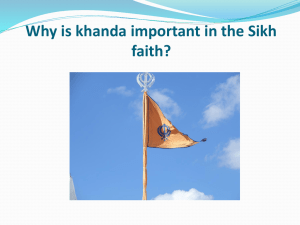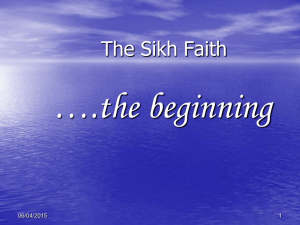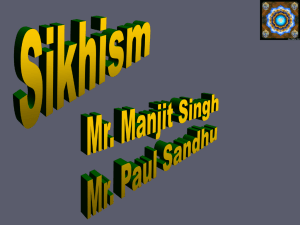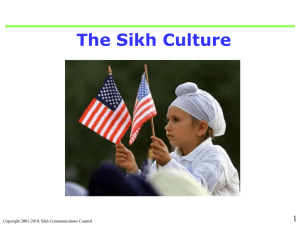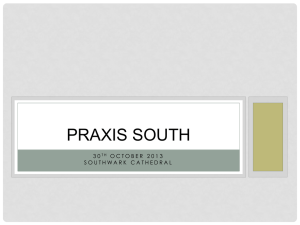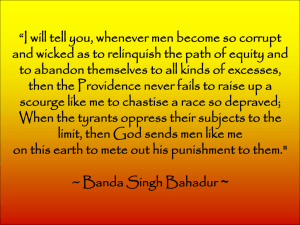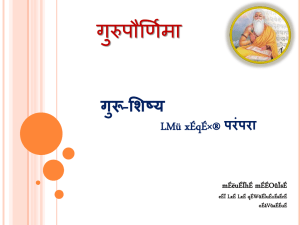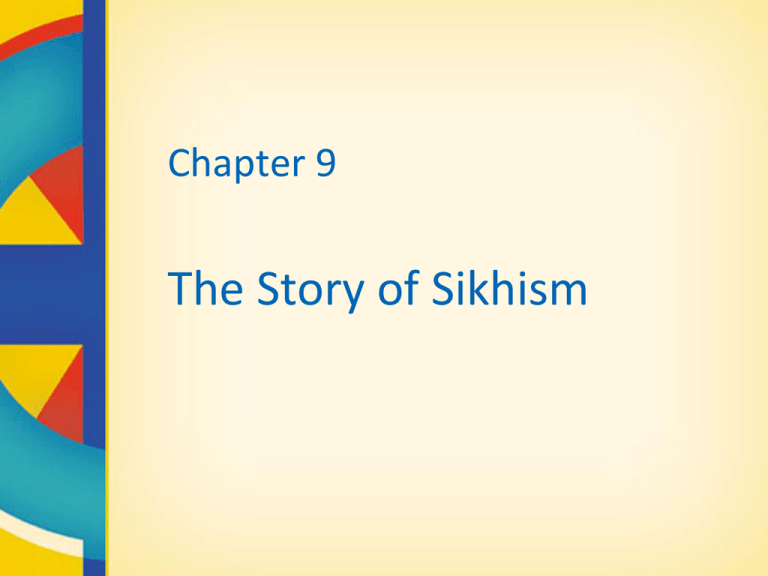
Chapter 9
The Story of Sikhism
Sikhism in Canada
• In the past, Sikhism was often mistakenly assumed to be an offshoot of
•
•
•
•
•
•
•
•
•
Hinduism.
But, it is a separate religion with its own scripture, art, architecture, ethics, and
military service.
Appreciation of Sikhism has grown greatly in recent years, especially in Canada.
Growing Sikh immigration to Canada in the last several decades has helped
with recognition.
Sikhs first came to Canada in the early 20th century, and settled mainly in
British Columbia.
In 2001, 278 410 Sikhs lived in Canada
– they accounted for almost 5% of the 1.8 million new immigrants to
Canada in the 1990s
Sikhs were not always accepted as immigrants.
In the early 20th century, they were often discriminated against in the
workplace, at school, and when looking for housing.
Today, discrimination is much less prevalent although it has not completely
disappeared.
Sikhs have contributed much to Canadian society.
The History of Sikhism
Guru Nanak
•
•
•
•
•
Sikhism’s origins are traced to one man—Guru Nanak.
Nanak was born into a Hindu warrior-caste family in Punjab, India, in 1469.
Punjab was home to Hindus and Muslims.
At about 30, Guru Nanak left his family to explore religion.
He had a vision where God appeared to him and told him to be the prophet of a
new religion with “no Hindu and no Muslim, but only one human being who is a
disciple of God.”
– His mission became to bridge the two faiths.
• He travelled through India, Iraq, Tibet, Sri Lanka, and Mecca, preaching to unite
the faiths.
The Ten Divinely Directed Gurus
• In Nanak’s religion, rituals were replaced with obedience to a divinely directed
•
•
•
•
guru.
In total, 10 gurus led the faith over the years.
Sikh gurus revealed truth from their own experience, whereas Hindu gurus
interpreted ancient Hindu scriptures.
Their revelations became the basis of Sikhism.
Sikhs believe the gurus were ordinary human beings blessed with divine grace.
The Granth Sahib and the Golden Temple
• The fifth guru, Arjun Dev, collected sacred hymns, poems, and Sikh wisdom
and compiled them into the Adi Granth, the Sikh scripture.
• He built the Golden Temple to house the holy book, and to be a gathering
place for Sikhs.
The Living Guru
• In 1708, three days before he died, the tenth guru, Gobind Singh, declared
there would be no more human gurus.
• From then on, the holy book of the Sikhs’ sacred writings would be the guru.
The Creation of Pakistan
• In August 1947, India became independent from Britain.
• Pakistan was created as a home country for Indian Muslims, to calm divisions
between Hindus and Muslims in India.
• About 1.5 million Muslims, Hindus, and Sikhs moved away from their homes
for fear of being part of a powerless minority.
• Sikhs were forced to abandon many of their holy places, such as the
birthplace of Guru Nanak, because they were on the Pakistani side of the
Punjab.
Rituals
Prayer
• The essence of the Sikh scriptures is in the first few pages of the Guru Granth
•
•
•
•
•
Sahib, called the Japji Sahib.
Sikh morning prayer begins with the Mul Mantra.
Sikhs recite five formal prayers throughout the day.
Prayer, or ardas, is an important part of Sikh ritual.
It consists of
– a call for the blessings of God and the 10 gurus
– a recitation of key events in the life of the 10 gurus and a short history of
the Sikhs
– a worshipful recitation of the name of God
– a call for peace, well-being, and prosperity for all humanity
Prayers for specific functions or reasons include a supplication to God for the
success of the function, gathering, or project.
The Gurdwara
•
•
•
•
Gurdwaras are the main centres of prayer and religious observances.
The main hall is plainly decorated, with no statues or images.
The central object of attention is the sacred scripture itself.
Like Hindus and Buddhists, Sikhs visit their place of worship whenever they
wish.
• No particular day of the week is holy.
• In Canada, Sikhs often go to a gurdwara on Sundays to align with Canadians
attending church services.
Worship in the Gurdwara
• Visitors remove their shoes before entering, and cover their heads.
• Visitors bow before the Guru Granth Sahib.
• After they place their offering and say a prayer, they back away respectfully
and find a place to sit.
• Men and women sit on either side of the hall, but there is no strict rule to
do so.
• Worship involves prayer, hymns, and reciting poems or other religious
compositions.
Worship in the Gurdwara (cont’d)
• Worship can be led by any member of the congregation who has studied the
•
•
•
•
•
•
•
•
•
Sikh scriptures.
The granthi is the person who performs the daily prayer service.
The main part of the service is the singing of hymns.
Ragis (professional hymn singers) normally play the music and lead the
singing.
The service includes short readings from Guru Granth Sahib.
Formal Sikh services last three to four hours, but people come and go as they
please.
At the end of the service, parshad, a sweet pudding-like dessert, is shared.
– Receiving the parshad is a key part of the hospitality practices in the
gurdwara.
People share a meal, called langar, that is prepared in the gurdwara’s
community kitchen.
The meal is a symbol of unity and equality of all people.
All people sit in rows on floor mats, regardless of their religion, age, gender,
or status.
Marking Time
• The fourth guru, Guru Ram Das, created the following routine:
1) Sikhs wake up every morning before dawn and bathe.
2) Morning prayer begins with meditation on the name of God,
followed by the rest of the Japji Sahib.
3) Sikhs then work to earn a living, but keep away from dishonesty and
unfairness.
4) Sikhs recall God’s name at every opportunity during the day.
5) Sikhs offer prayer again in the evening and before bed.
Life-Cycle Ceremonies
Birth and Naming
• The parents host a naming at the gurdwara.
• The granthi makes the amrit (ceremonial water also used in adult baptism)
by adding sugar to water and stirring it with a kirpan (a small sword or
dagger).
• Prayers are recited and hymns are sung to bless the newborn child.
• A random reading from the Guru Granth follows.
• The first letter of the first word of the reading becomes the initial letter of
the child’s name.
Baptism
• Guru Gobind Singh initiated the Baptism of the Sword ceremony in 1699.
• Baptized Sikhs are expected to wear symbols of their baptism at all times.
• These symbols are called the 5 Ks, and each has a special significance.
•
•
•
•
•
•
•
1) Kesh: Uncut hair and beard (symbolizes saintliness and respect for the
body)
2) Kangha: Wooden comb (symbolizes personal cleanliness)
3) Kachha: Short pants worn by the soldiers of the time (Khalsa Sikhs are
warriors, always ready to defend their faith)
4) Kara: Steel bracelet on the right wrist (symbolizes God, strength, and
fearlessness)
5) Kirpan: Small sword or dagger (symbolizes power and dignity)
Any man or woman can be baptized, at any age
Baptism takes place in the gurdwara.
Five members of the Khalsa explain the Khalsa obligations to the candidates,
who vow to live according to them.
The ardas (prayer) is recited, and a passage from the Granth is read.
Anyone accepting Sikhism for the first time is given a new name.
All baptized Sikhs share parshad.
Most Sikhs do not undergo baptism.
– They are not bound to wear the 5 Ks, but many choose to wear some of
them.
Marriage
•
•
•
•
•
•
•
•
The marriage ceremony is called Anand Karaj.
Marriage is a holy union, and family life has the highest honour.
Sikhs do not believe in celibacy (adults remaining single).
Marriages are arranged with help of parents and extended families, but
marriages are not always arranged in Canada.
Marriage can take place anywhere, as long as there are no intoxicants, such
as alcohol.
Sikhs are encouraged to marry other Sikhs, but there are no barriers to race,
caste, or status.
The main ceremony consists of reciting the sacred wedding hymn.
Each stanza gives important instructions for the couple on how to bring their
marriage into a true communion.
Funeral Rites
• The body is bathed, dressed in clean clothes, and placed on a wooden frame.
• If the person has been baptised, the 5 Ks are displayed on the body.
• Mourners form a procession and sing hymns as they carry the body to the
•
•
•
•
•
•
•
cremation ground.
In Canada, the procession may be a motorcade that drives to the
crematorium.
Public displays of grief are discouraged because of Sikhs’ strong belief in the
immortality of the human spirit.
After cremation, the ashes are disposed of in the sea or other body of water.
Some families take the ashes to the Sikh homeland in Punjab, India.
Friends and relatives return to the house of the deceased where they may
begin a ceremonial reading of the entire Guru Granth.
The task is undertaken by friends, family, and sometimes a paid reader, and is
to be completed in 9 days.
On the last day, the mourners reassemble for the reading of the final five
pages of the Guru Granth, the ardas (prayer), a random reading from the
Granth, and the sharing of the parshad.
Festivals and Holy Days
Nanak Jayanti
• This is Guru Nanak’s birthday, and takes place in November or December.
• Sikhs celebrate with processions and reading the Guru Granth Sahib
continuously for three days before the holiday.
Baisakhi
• This is the birthday of the Khalsa, and the Sikh New Year.
• It remembers the first Baptism of the Sword.
• Baptisms take place on this day, and the Guru Granth is carried through the
streets in procession.
• It also celebrates the beginning of the spring harvest, especially in the Punjab.
The Community
The Gurdwara
• The gurdwara is a centre for community life and charity.
• Sikhs believe service to humankind is service to God.
• Giving money to the needy and sharing meals together, including with
strangers, are important acts of service.
• A langar (free kitchen) is always part of the gurdwara.
Branches of Sikhism
• There are three main branches of Sikhism:
– Khalsa or Singhs: initiated, baptized Sikhs
– Keshdhari: Sikhs who keep their hair uncut and wear a turban, but have
not been baptized
– Sahajdhari: Sikhs who accept the beliefs and philosophies of Sikhism, but
do not take the baptismal vows; they cut their hair and do not wear a
turban
Major Teachings
• The 10 gurus and Guru Granth Sahib provide Sikhs with a beliefs system on
how to worship and live their lives.
1. Monotheism
• There is only one God: Creator, Timeless, Unincarnated (without a physical
body), Eternal.
2. The Reality of the World
• The world is good – it is not an illusion, nor a source of suffering.
• Human life is an opportunity to become one with God.
3. Spiritual Achievement in This Life
• The goal of life is to escape our self-will or self-interest and become one with
God.
• The highest achievement is to become a Gurmukh (a God-man), who is
selfless and completely in touch with the will of God.
4. Union of Spiritual and Worldly Lives
• Guru Nanak did not believe in asceticism.
• Sikhs are involved in community life, take care of the poor, and act against
injustice.
• Consumerism and materialism are strongly discouraged.
5. Nam
• Nam is the presence of God in each human heart.
• Sikhs must strive to keep this “God-within” in mind at all times to become more
loving, truthful, humble, and content.
6. Good Deeds, Not Rituals
• Ritualism is condemned.
• Sikhs feel that at the end of their lives, they will be judged solely on the quality
of their actions.
7. Equality and Human Dignity
• Sikhs profess that all humans are equal.
• Nanak rejected the Hindu caste system entirely.
• Sikhs profess the equality of women and men.
8. A Just Society
• Nanak wanted to establish a just and compassionate society on Earth.
• In his ideal community, all would work together, pray together, eat together and
be treated equally.
Morality
Social Responsibility
• The Rahit (or Reht) Maryada is the Sikh code of moral conduct.
• It provides guidelines for how to perform religious rites and live an ethical
•
•
•
•
life.
It is based on the teachings of the 10 gurus and the Guru Granth Sahib.
Sikhism teaches that God, who created everything, gave people free will, and
they must make moral choices.
Sikhism requires its followers live according to three principles:
– devotion to the Divine Name
– earning an honest living
– sharing earnings with those less fortunate
Gaining wealth is not against Sikhism, as long as it is gained in an honest way
and help is given to those in need.
Sikh Virtues and Vices
• The Gurus encourage five virtues and discourage five vices.
– Virtues: Truth, Contentment, Patience, Perfect Faith, and Compassion
– Vices: Lust, Anger, Greed, Attachment, Pride
• Sikh morality
– prohibits sex outside marriage and forbids adultery
– urges that all people be treated as equals
– encourages Sikhs to keep good company, and to act modest and humble
– requires Sikhs to contribute 1/10 of their earnings to charitable causes
– requires Sikhs to take part in the langar
• Homosexuality is not mentioned specifically, but most Sikhs see it as inconsistent
•
•
•
•
with nature.
The code forbids intoxicants, smoking, and eating of kosher or halal meat.
Sikhs strive to uphold the role of women as being equal to men.
– Women are encouraged to develop spiritual lives through prayer, song,
and attendance at the gurdwara.
– Women participate equally in and perform all ceremonies, including
baptism.
Sikhs religion aims to improve the world by direct action.
Sikhs believe that God has given them the blessings they need to turn any
situation toward the good.
Family Life
• Sikhs believe all adults should marry, if possible.
• They consider family life to be of the highest honour.
– Family life lived with virtuous behaviour and sincere faith in God leads to
•
•
•
•
•
salvation.
Children learn the beliefs and morals of Sikhism at home.
Divorce is not encouraged, but it is permitted, especially on the grounds of
cruelty, adultery, or change of religion.
Second marriages after divorce are permitted.
Remarriage after the death of a spouse is encouraged.
Young Sikhs are often discouraged from dating because Sikhs believe sex
outside of marriage is wrong.
Interreligious Dialogue
Sikhism and the Catholic Church
• Dialogue between Sikhs and Catholics began in New York in 2006.
• They have committed to meeting regularly to discuss matters of common
concern.
• The first encounters were to raise the level of trust and mutual understanding.
• Sikhs are proud of their history of religious tolerance.
Profile: Yogi Bhajan
• He was born in Punjab and became a master of Kundalini, an ancient form of
•
•
•
•
•
yoga.
He immigrated to Canada to teach it to the Western world.
He became known for his 3HO movement, which stated it was the birthright of
all people to be “Healthy, Happy, and Holy.”
Yogi Bhajan met with leaders of all faiths to encourage dialogue.
He encouraged Pope Paul VI to bring religious leaders together and, after the
pope’s death, continued his relationship with the Catholic Church.
He became co-president of the World Fellowship of Religions in 1974 and
established the first International Peace Prayer Day for people of all faiths,
which continues around the world today.



